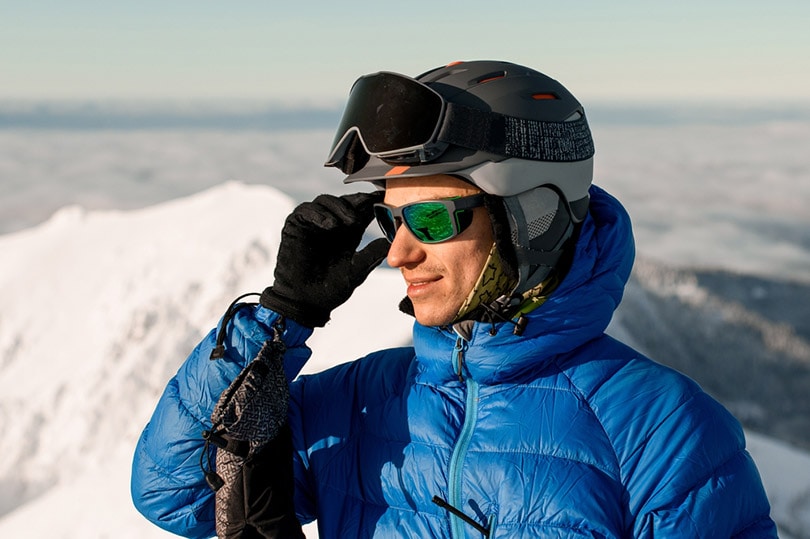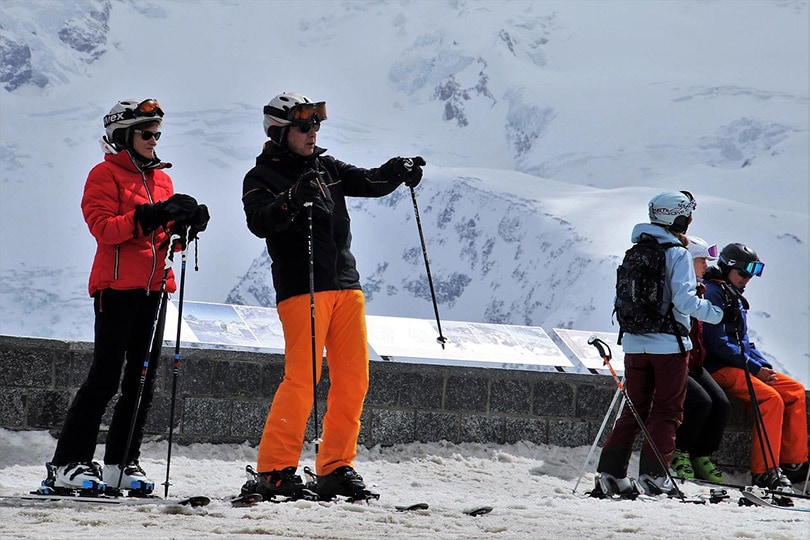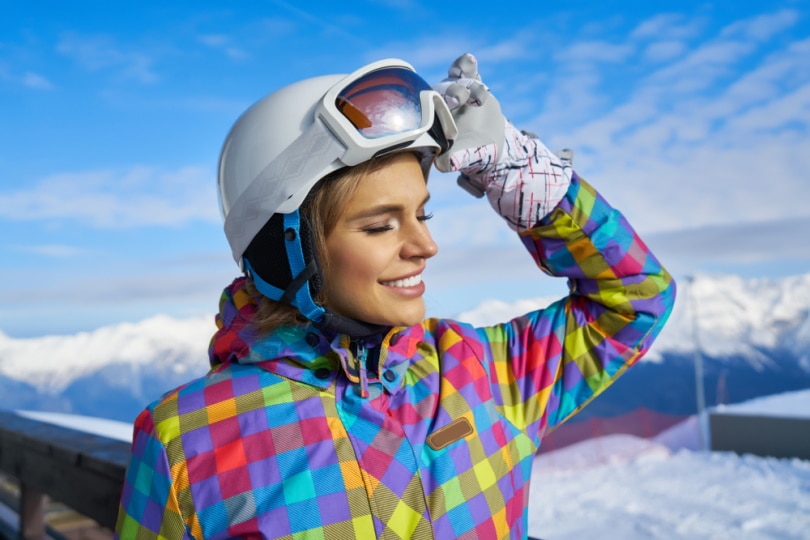Can You Wear Glasses Under Ski Goggles?
Last Updated on

Protection is essential for snowboarders and skiers alike. While some opt for wearing ski glasses under their ski goggles, others prefer replacing the glasses with contact lenses. Such pairings are pretty common among skiers, so you can surely wear glasses with your ski goggles.
However, this method is only effective when you choose the right goggles and glasses combination. The perfect way is to go for the glasses that are one size smaller than your goggles so that both sit on your face comfortably.
It’s always intelligent to try wearing glasses under your ski goggles before going on the trip. This way, you can determine any aspect that you’ve overlooked. For instance, sometimes the goggles and glasses can steam up and create fog.
If you’ve decided to wear glasses under ski goggles, there are many things you need to consider. We have tried to clear up all your confusion in this guide, so keep reading.

What Ski Goggles Fit Best Over Glasses?
Pairing your goggles with glasses is the best way to enjoy a safe adventure. However, you need to find the right pair of goggles that fit over glass perfectly. Choosing one isn’t that hard if you know the common types of ski goggles. Here are some:
Over the Glass (OTG) Goggles
You may already have guessed by the name. The OTG ski goggles are specially designed to be worn over your glasses. Their construction doesn’t cause any inconvenience for the wearer since you can easily adjust the extra padding and lengthy straps according to your glasses’ frame size.
Oversized Ski Goggles
Oversized ski goggles are the safest options when confused about choosing the right fit. You can easily find a polarized ski goggle suitable for daytime use, too. To ensure that your goggles sit comfortably over your glasses, it would be wise to buy oversized ski goggles from any quality brand.
Goggles with Lengthy Straps
Many ski goggles come with a non-adjustable, fixed strap, making it hard for you to wear glasses under them. So, when you go for your ski equipment shopping, always prefer ski goggles with adjustable straps. This way, you can easily find the right fit glasses to wear underneath them.
Goggles with Fans
Some ski goggles also come with a built-in fan to prevent fogging. The fan keeps running to dry off sweat droplets from your face. However, one downside is that the fan operates on a battery, so you may have to keep extra batteries on your person.
Graphene-Infused Ski Goggles
These goggles come with a graphene heating film that manages the air density and moisture inside the goggle. The good thing is that you can adjust the heating levels of these goggles as per your requirements and weather conditions.

How to Ensure Glasses Fit Under Ski Goggles
Once you’ve chosen the correct type of goggles, the next step is to find the most-suitable glasses. Of course, it’s not easy to get the perfect combination of glasses and goggles.
So, consider these few things to ensure that your glasses fit under your ski goggles:
Perfect Frame
Sports or athletic glass frames are the perfect choices to wear under ski goggles. They have a flexible construction that helps them sit on your face perfectly compared to other Athletic glasses also don’t come off quickly like other ordinary ones.
Proper Ventilation
To prevent fogging, your goggles and glasses should have a proper ventilation system. Try to find the ones with more vents near the edges that ensure minimum steam buildup.
Going One Size Down
Glasses that are one size smaller than the goggles always create the perfect combination. However, if you’re buying glasses that you wish to only wear under the goggles, never go for the perfectly fitted one, or else it may constrict the internal environment of your goggles, making some people claustrophobic.
Everything Must Blend In
The complete ski outfit also comprises a helmet, glasses, and goggles. Ensure that all these things complement each other and that nothing is too loose or too fit. Also, avoid buying a helmet that can restrict the vents of your ski goggles.

How to Keep Glasses and Goggles From Fogging Up While Skiing
Although wearing glasses under ski goggles comes with many benefits, it can become a problem if not done correctly. You can face several mishaps during your trip. Fogging is one of the significant issues that skiers and snowboarders face when wearing goggles over glasses.
Thus, you need to consider a few things to make the most out of this combination. First, you need to ensure that your glasses are designed explicitly for skiing. Of course, you look fantastic in those large frames, but they are usually too stiff and bulky to wear under ski goggles for long. As mentioned above, slim athletic frames are the perfect choice for snowboarding or skiing.
Generally, when the temperature difference between the inside of your goggles and the outside rises, it results in fogging of the glasses. So, the best way is to optimize the temperature properly by not sliding your goggles to your forehead. Otherwise, the sweat on your head will cause fogging.
Understandably, you won’t be wearing your goggles all the time. There will be moments when you’d have to take them off. If not handled carefully, it may cause fogging without you even knowing.
- Don’t put your goggles back on immediately after taking them off. Instead, it’s better to wait for a few moments to allow your face and glasses to return to normal temperature.
- Ensure that your ski mask isn’t accumulating the warm air that comes out of your nose and mouth and directing it into the bottom of the goggle.
- After coming back from skiing, remember to take out your goggles from the bag and put them in a warm and dry place for the night to dry.
- If your ski goggles still fog up, don’t wipe the moisture from the lens when it’s wet because you may damage the anti-fog coating of the goggles’ lens.
Prescription Ski Goggle Inserts
Luckily, if you feel intimidated by the fogging fiasco, you’ve got an alternative for the OTG goggles—a prescription goggle insert. If you’re a beginner skier, you may be wondering what this is.
Prescription goggle inserts are actually inserted systems that work with almost any type of goggles. Prescription goggle inserts are designed by eyewear companies and opticians, especially for people who find wearing glasses under ski goggles challenging.
This system combines prescription lenses with the inside of the ski goggles and incorporates them into the goggle system. Such lenses also have unique coatings that prevent fogging.
The best part about using prescription inserts is that you don’t have to find the right size and type of goggles and glasses. This system works with almost any ski goggles and lenses and has a meager chance of causing fog.
Prescription inserts are relatively more expensive than OTG goggles and glasses. Moreover, since these inserts are integrated into your goggle system, you’ll automatically take your glasses off with your goggles.
Therefore, if you still want to go for prescription inserts, keep a pair of glasses as a backup.

Wearing Contacts While Skiing
Believe it or not, contacts can make your entire skiing and snowboarding experience much easier. However, they might not be a suitable option for everyone, so it’s better to consult your optometrist to make the right decision.
If your optometrist agrees, great! All you have to do is put them on after waking up and wear any goggles over them.
Unfortunately, wearing contacts also has some downsides. For example, if you have sensitive eyes or follow a specific prescription, you can’t wear contacts. In addition, contacts can quickly come off if you experience a hard crash.
So, if you’re willing to take the contacts route, always bring additional contacts in your luggage.

Conclusion
Wearing glasses under ski goggles is quite common among skiers and snowboarders. Doing so provides them with several benefits and ensures protection all day long. In addition, by choosing the right size and fit of glasses, you can prevent fogging and enjoy your adventure without any disturbance.
Featured Image Credit: Maksym Fesenko, Shutterstock
About the Author Jeff Weishaupt
Jeff is a tech professional by day, writer, and amateur photographer by night. He's had the privilege of leading software teams for startups to the Fortune 100 over the past two decades. He currently works in the data privacy space. Jeff's amateur photography interests started in 2008 when he got his first DSLR camera, the Canon Rebel. Since then, he's taken tens of thousands of photos. His favorite handheld camera these days is his Google Pixel 6 XL. He loves taking photos of nature and his kids. In 2016, he bought his first drone, the Mavic Pro. Taking photos from the air is an amazing perspective, and he loves to take his drone while traveling.
Related Articles:
Can You Use Binoculars to Look At Stars? How to Choose the Right Pair
How to Clean a Refractor Telescope: Step-by-Step Guide
How to Clean a Telescope Eyepiece: Step-by-Step Guide
How to Clean a Rifle Scope: 8 Expert Tips
Monocular vs Telescope: Differences Explained (With Pictures)
What Is a Monocular Used For? 8 Common Functions
How to Clean a Telescope Mirror: 8 Expert Tips
Brightfield vs Phase Contrast Microscopy: The Differences Explained
